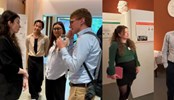Nobel insights on growth: We can’t take progress for granted
The 2025 Nobel Prize in Economic Sciences in Memory of Alfred Nobel was awarded to Joel Mokyr, Philippe Aghion and Peter Howitt for explaining innovation-driven economic growth. Their research shows why the world, for the first time in history, has experienced continuous progress over the past two centuries.
“Understanding the forces behind sustained growth is extremely interesting and important,” says Anna Dreber Almenberg, Professor of Economics at the Stockholm School of Economics and a member of this year’s Nobel Prize Committee. “There have been many periods of innovation before, but they didn’t lead to sustained growth. The laureates have figured out what made this possible and what is necessary for this growth to continue.”
The prize was divided, with Joel Mokyr receiving one half and Philippe Aghion and Peter Howitt sharing the other, each contributing a different perspective on how innovation drives long-term growth. Mokyr explored how the Industrial Revolution emerged in Britain, emphasizing the interaction between science and technology and openness to ideas. Aghion and Howitt developed a mathematical theory of sustained growth based on creative destruction, showing how new technologies replace old ones.
“Creative destruction leads to tensions between those that are currently on top of the innovation ladder and risk being pushed off and those that are on their way up,” Dreber Almenberg explains. “Mokyr showed how British society with new institutions was ready to handle such tensions in constructive ways.”
The evolution of economic thought
Dreber Almenberg sees the laureates’ work as reshaping how economists think about the link between science, technology, innovations and growth. “Before the Industrial Revolution, people often knew that something worked, but not why,” she explains. “The Enlightenment and the scientific revolution changed that. When skilled practitioners could turn this knowledge into commercial products, we got innovation-driven growth.”
She adds that the same principle applies today. “We can’t take growth for granted. We need openness to new ideas and people who can turn new knowledge into practice.”
Growth and sustainability
The laureates’ insights also speak to today’s challenges. “Sustained growth and sustainable growth are not necessarily the same,” Dreber Almenberg says. She notes that some of Philippe Aghion’s recent work focuses on green growth. “He studies how innovation can stay an engine for development while reducing the environmental impact,” she says. “Aghion and Howitt describe an innovation ladder where new ideas build on older ones. If that ladder depends on fossil fuels, we risk getting stuck dependent on fossil fuels. Policy can help shift innovation toward greener energy.”
Preparing for change
Dreber Almenberg believes artificial intelligence could play a major role in shaping the next phase of innovation. “AI has the potential to increase the rate at which useful knowledge is generated which could lead to an acceleration of new innovations,” she says.
At the same time, she notes, technological change always disrupts. “Some people benefit from innovations while others are negatively affected or simply lose out,” she says. “The work of the laureates emphasize that there needs to be support for those that lose their jobs because of creative destruction.”
The laureates have also warned that both too high and too low market concentration can hold back innovation. “If only a few firms dominate, innovation can slow down. The model of Aghion and Howitt could potentially explain why growth has fallen in recent times.”
Looking ahead
The work of Mokyr, Aghion and Howitt is a reminder that economic growth cannot be taken for granted. “The last two hundred years have been exceptional,” she says. “Sustained growth relies on curiosity, openness to new ideas and a willingness to adapt. If we stop encouraging new ideas and innovations or fail to manage change constructively, we risk losing the very forces that made sustained growth possible in the first place."
This year's Nobel laureates in economic sciences
Joel Mokyr
Professor at Northwestern University, Evanston, IL, USA
Born 1946 in Leiden, the Netherlands
PhD from Yale University, 1974
Philippe Aghion
Professor at Collège de France and INSEAD, Paris, France, and at the London School of Economics and Political Science, UK
Born 1956 in Paris, France
PhD from Harvard University, 1987
Awarded an honorary doctorate at the Stockholm School of Economics in 2005
Peter Howitt
Professor at Brown University, Providence, RI, USA
Born 1946 in Canada
PhD from Northwestern University, 1973
The Sveriges Riksbank Prize in Economic Sciences in Memory of Alfred Nobel
The Sveriges Riksbank Prize in Economic Sciences in Memory of Alfred Nobel was created in 1968 by Sweden’s central bank, Sveriges Riksbank, to mark its 300th anniversary. Funded through a donation to the Nobel Foundation, the prize follows the same principles as the Nobel Prizes established by Alfred Nobel in 1901.
The award recognizes outstanding contributions to the field of economics and carries the same monetary value as the Nobel Prizes, financed by Sveriges Riksbank. The first laureates, Ragnar Frisch and Jan Tinbergen, received the prize in 1969. The Royal Swedish Academy of Sciences in Stockholm is responsible for selecting the laureates each year.




